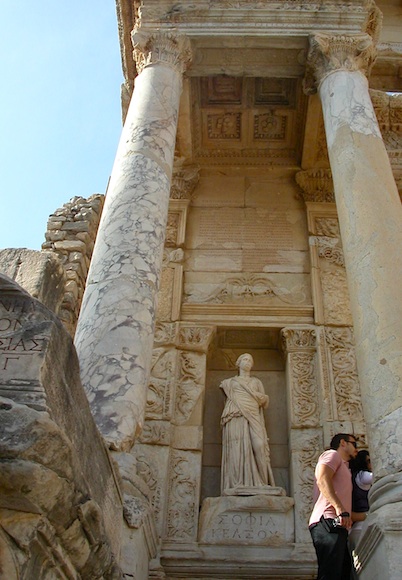
Incorporation of Ephesus into the Roman Republic proved tumultuous as taxes rose and the treasures of the city were systematically plundered – a practice that would contribute to the Vespers of 88 BCE, an infamous episode responsible for starting the First Mithridatic War, when the king of Pontus, Mithridates the Great, used local discontent with the Romans and their taxes, to orchestrate the execution of some 80’000 Roman and Italian citizens (effectively anyone who spoke with a Latin accent) across Asia Minor.
Having heard word of the massacre at Chios by his general Zenobius, they invited the general into Ephesus when he arrived at the city, but refused entry to his army. Once within the city, general Zenobius was executed for fear of his intentions for Ephesus. Despite this treason, these massacres led the Roman Senate to invade the Kingdom of Pontus in an attempt to annex the territory, and as the First Mithridatic War waged on, the Greek cities were permitted to govern themselves, in exchange for their obedience. But with Mithridates’ defeat in 86 BCE by the Roman consul Lucius Cornelius Sulla, Ephesus came back under Roman rule. And was immediately punished with five years of back taxes, plunging the city heavily into debt for almost sixty years.
However with the rise of Emperor Augustus in 27 BCE, Ephesus was named capital of the Asia pro-consular and entered into an era of prosperity as the seat of the governor. The city grew into a metropolis and major commerce centre, second in importance and size only to Rome. Reaching its peak during the first and second centuries, Ephesus would grow to become the largest city in all of Roman Asia.
Famed not only for the Temple of Artemis, Ephesus was known throughout the empire for the Library of Celsus, and its great theatre, capable of seating almost 30’000 spectators, but also boasted one of the most advanced aqueduct systems in the ancient world, with a multitude of aqueducts in all manner of sizes supplying water to the different parts of the city – including even a water mill driven sawmill for cutting marble.
However all this splendor would again see decline when the empire was overrun by the Goths, who wrought terrible destruction upon Ephesus in 263 CE.
![Ephesus sites: Library of Celsus [Repost]](http://www.cultureaddicthistorynerd.com/wordpress/wp-content/uploads/2013/09/celsus-library-150x150.jpg)
![The decline of Ephesus [Repost]](http://www.cultureaddicthistorynerd.com/wordpress/wp-content/uploads/2012/06/celsus-library-150x150.jpg)
![Ancient ruins: Efes (Ephesus), Kusadasi [Repost]](http://www.cultureaddicthistorynerd.com/wordpress/wp-content/uploads/2011/12/gary_ephesus-150x150.jpg)
![Ephesus: Ancient Christian Centre [Repost]](http://www.cultureaddicthistorynerd.com/wordpress/wp-content/uploads/2012/07/ephesus-mainstreet-150x150.jpg)
![The founding of Ephesus [Repost]](http://www.cultureaddicthistorynerd.com/wordpress/wp-content/uploads/2012/03/nic_columns-150x150.jpg)
![The Temple of Olympian Zeus [Repost]](http://www.cultureaddicthistorynerd.com/wordpress/wp-content/uploads/2012/01/garyandnic_zeus-150x150.jpg)



































